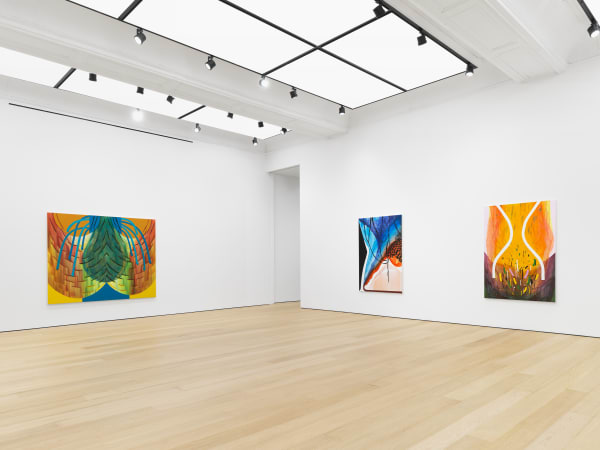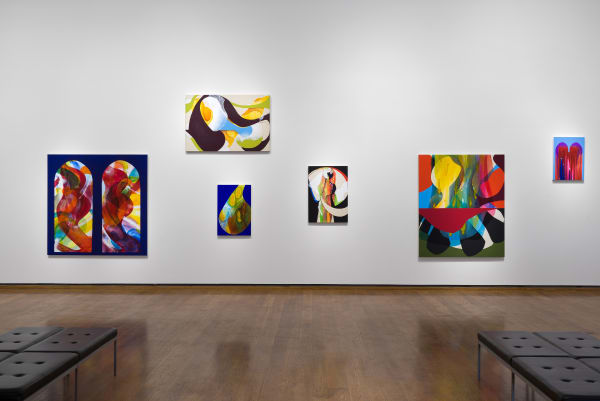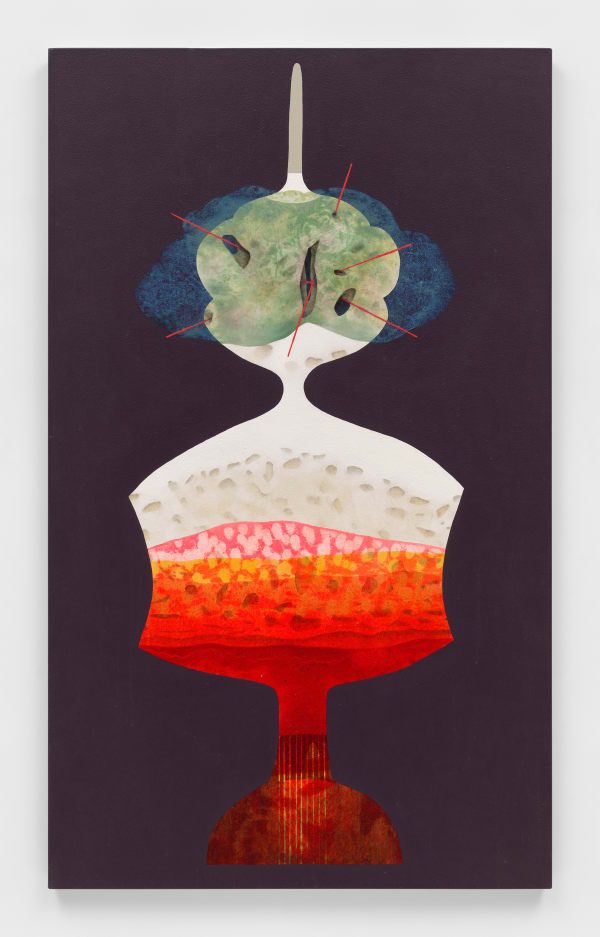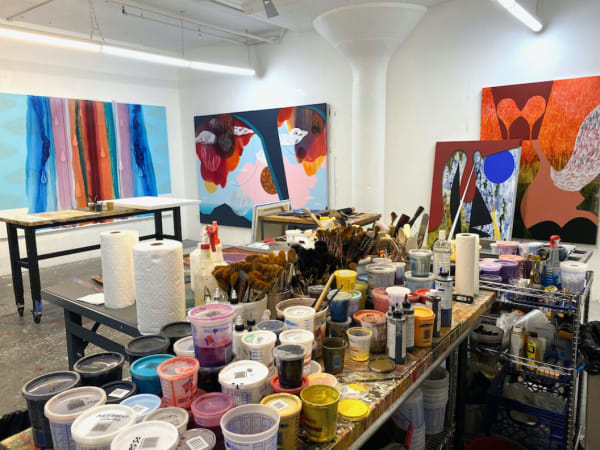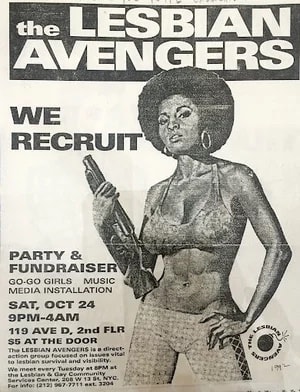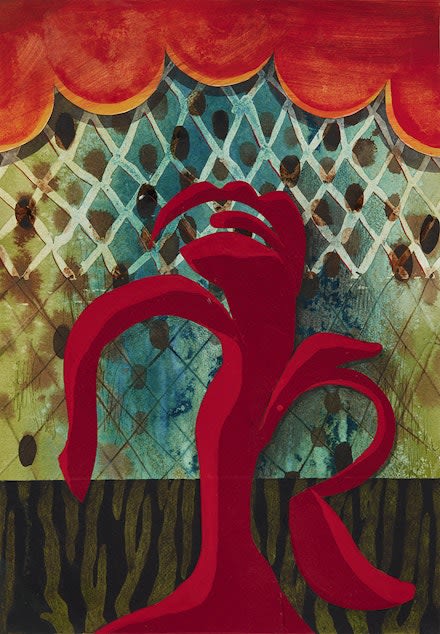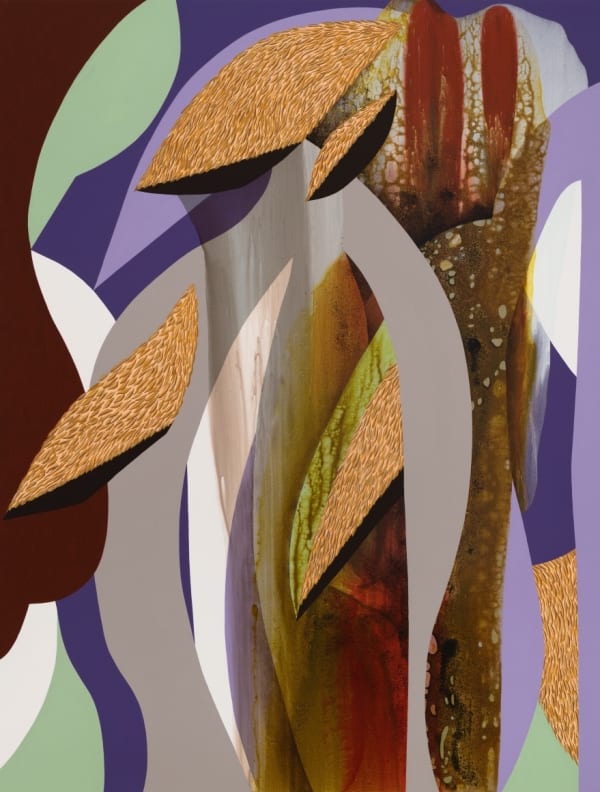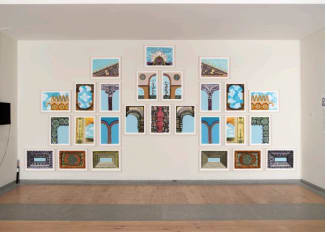Carrie Moyer
-
Biography
Carrie Moyer (b. 1960) was born in Detroit, MI, and lives and works in Brooklyn, NY. Her vibrant paintings and works on paper critically interrogate the formal and conceptual conventions of painting while embracing an approach to abstraction rooted in optical pleasure. Moyer’s playful compositions, layered surfaces, and fluid forms, which freely oscillate between abstraction and representation, speak not only to her commitment to feminist political theory, but also to her deep investment in art history. As she explains, “What is political about my painting is its basis in my own experience. The work engages the history of 20th-century painting from the margins, a position defined by humor, exuberance, and disruption.”
Moyer studied modern dance at Bennington College before receiving her BFA from Pratt Institute, an MA in computer graphic design from New York Institute of Technology, and an MFA in painting from Bard College. While at Pratt, Moyer interned at Heresies, the seminal feminist journal on art and politics. After graduating, Moyer continued her social activism, creating a series of agitprop posters and works on paper. This early body of work, which explored the representation of queer women in mainstream media, led to the formation of Dyke Action Machine! (DAM!; 1991–2004), a collaborative public art project with the photographer Sue Schaffner. Inserting imagery of borderline stereotypical lesbian identity into various commercial contexts, Moyer and Schaffner plastered high-volume poster campaigns across the city. Often pasting over existing advertisements with their own agitprop images that centered and celebrated queer women, DAM! challenged the heteronormative nature of societal representation. Upon returning to painting, Moyer recalls, “part of the friction was how could I bring the sentiment and urgency of the agitprop I’d made for queer organizations and Dyke Action Machine! into the studio. How does one render it through abstraction?”
Moyer’s history of social activism informs her approach to painting, which marries the graphic flatness of her posters with the more sensual material qualities of the medium. Expanding on processes common to Color Field painters, her practice involves drawing, pouring, staining, rolling, sprinkling, and mopping. At the same time, Moyer also employs strategies and techniques found in graphic design. Achieving multidimensional effects through gradation, transparency, and shadows, Moyer builds her images layer-by-layer, using thin veils of aqueous color, mirrored images, and outlined biomorphic forms. Her techniques obfuscate her paintings’ making to forward an unfettered, sensorial approach to looking—one divorced from the technical mechanics of construction. Further emphasizing the sensorial, since 1999, Moyer has incorporated glitter into her work. For the artist, glitter injects the “material language of queerness” into her compositions. “For me, glitter signified disco and gay icons such as Sylvester,” she explains. “… [Glitter represented] this other part of my life that seemingly didn’t jive with the seriousness of a painting practice.” Decades later, glitter has become a signature element in her paintings that, per Moyer, “draws a different kind of light to the canvas.”
Just as Moyer combines different techniques and media in her paintings, so too does she draw on a variety of source material to inform her compositions. Alluding to the natural world, yet transcending specific references, her approach centers feminist ideologies while simultaneously recalling the unexpected juxtapositions of Surrealists, who, like Moyer, sought to establish “new relationships, and new possibilities.” As the writer and critic Lauren O’Neill-Butler summarizes, “Moyer recommits to form and formalism in order to blow both up—that is, to show how abstraction is never really a retreat from gender or identity but rather one way of opening up new and exhilarating ideas about embodiment.”
Ultimately for Moyer, the disparate bodies of work that define her extensive practice, the agitprop posters and paintings, are one and the same. Together, they shed light onto gender politics while also expanding and destabilizing traditional notions of abstraction. The artist concludes, “The posters and paintings share a declarative, public-facing voice that is transmitted through the use of symmetry and other framing devices, melding the idealistic fervor of twentieth-century abstraction and agitprop with a metaphysics of the lesbian body.”
Moyer’s work has been widely exhibited in one-person and group presentations, including Carrie Moyer and Sheila Pepe: Tabernacles for Trying Times, Portland Museum of Art, ME (2020), traveled to Museum of Arts and Design, New York (2021); Carrie Moyer: Pirate Jenny, The Frances Young Tang Teaching Museum and Art Gallery at Skidmore College, Saratoga Springs, NY (2013); traveled to Canzani Center Gallery, Columbus College of Art and Design, OH (2014); and SCAD Museum of Art, Savannah, GA (2014); Carrie Moyer: Interstellar, Worcester Art Museum, MA (2012); and Carrie Moyer: Painting Propaganda, American University Museum at the Katzen Center for the Arts, Washington, D.C. (2009), among others. Other recent exhibitions include Queer Abstraction, Des Moines Art Center, IA (2019), traveled to Nerman Museum of Contemporary Art, Johnson County Community College, Overland Park, KS (2019); Aftereffect: Georgia O’Keeffe and Contemporary Painting, Museum of Contemporary Art, Denver, CO (2019); Inherent Structures, Wexner Center for the Arts, Columbus, OH (2018); Whitney Biennial 2017, Whitney Museum of American Art, New York (2017); Agitprop!, Brooklyn Museum, New York (2015), among others. The artist’s works are represented in prominent collections, including Birmingham Museum of Art, AL; Des Moines Art Center, IA; The Frances Young Tang Teaching Museum and Art Gallery at Skidmore College, Saratoga, NY; The Metropolitan Museum of Art, New York; Mount Holyoke College Art Museum, South Hadley, MA; Rose Art Museum, Brandeis University, Waltham, MA; Weatherspoon Art Museum, University of North Carolina, Greensboro; Whitney Museum of American Art, New York, among others. She is the recipient of numerous awards and fellowships, including Civitella Ranieri Fellowship, Perugia, Italy (2019); National Academician, National Academy of Design (2019); American Academy of Arts & Letters (2018); Guggenheim Fellowship (2013): Anonymous Was A Woman (2009); and Art Matters Fellowship (1994). Moyer is a Professor and the Co-Director of the graduate studio program at Hunter College in New York. She is also on the Board of Governors at Skowhegan School of Painting and Sculpture in Maine.
-
Series
-

Agitprop
After receiving her BFA from Pratt Institute in Brooklyn, NY, Carrie Moyer created a series of agitprop posters and works on paper. This early body of work, which explored the... -

Paintings
Carrie Moyer’s history of social activism informs her approach to painting, which marries the graphic flatness of her earlier agitprop posters with the more sensual material qualities of the medium.... -

Works on Paper
As in her paintings, Carrie Moyer combines different techniques and media in her works on paper, drawing on a variety of source material to inform her compositions. Working on paper,...
-
-
Exhibitions
-

Carrie Moyer
Timber! September 12 - October 26, 2024 New YorkAlexander Gray Associates, New York presents Carrie Moyer: Timber! , the artist’s first solo exhibition with the Gallery. Moyer’s new abstract paintings and works on paper speak to the sensations...Read more -

I Spy
June 23 - August 27, 2023 GermantownAlexander Gray Associates, Germantown presents I Spy , a group exhibition of paintings, works on paper, and sculptures by Jennie Jieun Lee , Carrie Moyer , and Betty Parsons ....Read more -

Count of Three
April 18 - May 24, 2019 New YorkAlexander Gray Associates presented Count of Three , a survey of abstract painting from the 1960s to the present that takes structure—both formal and metaphysical—as a position to work within...Read more
-
-
Other Exhibitions
-

Carrie Moyer & Sheila Pepe: Tabernacles for Trying Times
Museum of Arts and Design May 22, 2021 - February 6, 2022Carrie Moyer's two-person exhibition Carrie Moyer & Sheila Pepe: Tabernacles for Trying Times at the Museum of Arts and Design, New York, NY. The Museum of Arts and Design's press... -

Queer Abstraction
Des Moines Art Center June 1 - September 8, 2019Harmony Hammond and Carrie Moyer included in the group exhibition Queer Abstraction , curated by Jared Ledesma, at the Des Moines Art Center, IA. The Des Moines Art Center's press... -

Whitney Biennial 2017
Whitney Museum of American Art March 17 - June 11, 2017Carrie Moyer included in the Whitney Biennial 2017 at the Whitney Museum of American Art, New York, NY. The Whitney Museum of American Art's press release follows: The 2017 Whitney... -

The Three Graces: Polly Apfelbaum, Tony Feher and Carrie Moyer
Everson Museum of Art September 25, 2015 - January 3, 2016Carrie Moyer included in the group exhibition Three Graces: Polly Apfelbaum, Tony Feher and Carrie Moyer at the Everson Museum of Art, Syracuse, NY. The Everson Museum of Art's press... -

Pretty Raw: After and Around Helen Frankenthaler
Rose Art Museum February 11 - June 7, 2015Harmony Hammond and Carrie Moyer included in the group exhibition Pretty Raw: After and Around Helen Frankenthaler at the Rose Art Museum, Brandeis University, Waltham, MA. The Rose Art Museum's... -

Carrie Moyer: Pirate Jenny
Frances Young Tang Teaching Museum January 26 - May 19, 2013Carrie Moyer's one-person exhibition Carrie Moyer: Pirate Jenny at the Frances Young Tang Teaching Museum and Art Gallery at Skidmore College, Saratoga Springs, NY. The Frances Young Tang Teaching Museum's... -

Carrie Moyer: Interstellar
Worcester Art Museum February 19 - August 19, 2012Carrie Moyer's solo exhibition Carrie Moyer: Interstellar at the Worcester Art Museum, MA. The Worcester Art Museum's press release follows: Carrie Moyer’s painting practice over the past two decades has...
-
-
Public Collections
Birmingham Museum of Art, AL
Des Moines Art Center, IA
Eli and Edythe Broad Art Museum, Michigan State University, East Lansing
Everson Museum of Art, Syracuse, NY
Fine Arts Museums of San Francisco, CA
The Frances Young Tang Teaching Museum and Art Gallery at Skidmore College, Saratoga Springs, NY
Joel and Lila Harnett Museum of Art, University of Richmond, VA
The Metropolitan Museum of Art, New York
Mount Holyoke College Art Museum, South Hadley, MA
Pizzuti Collection of the Columbus Museum of Art, OH
Portland Museum of Art, ME
Rose Art Museum, Brandeis University, Waltham, MA
Springfield Art Museum, MO
Weatherspoon Art Museum, University of North Carolina, Greensboro
Whitney Museum of American Art, New York
Worcester Art Museum, MA -
Videos
-
News / Events
-

Harmony Hammond, Carrie Moyer, Joan Semmel, and Dyani White Hawk
Making Their Mark: Works from the Shah Garg Collection at Mildred Lane Kemper Art Museum, Washington University in St. Louis September 12, 2025–January 5, 2026Harmony Hammond, Carrie Moyer, Joan Semmel, and Dyani White Hawk are included in the group exhibition Making Their Mark: Works from the Shah Garg Collection at the Mildred Lane Kemper Art Museum, Washington University in St. Louis, Missouri, on view from September 12, 2025–January 5, 2026.Read more -

Harmony Hammond, Carrie Moyer, Betty Parsons, and Joan Semmel
Flesh Flowers at the Aïshti Foundation October 27, 2025–January 1, 2026Harmony Hammond, Carrie Moyer, Betty Parsons, and Joan Semmel are included in the group exhibition Flesh Flowers at the Aïshti Foundation, Beirut, Lebanon, on view from October 27, 2025–January 1, 2026.Read more -

Carrie Moyer
History or Premonition at the Joan Mitchell Center August 1–30, 2025Carrie Moyer is included in the group exhibition History or Premonition at the Joan Mitchell Center, New Orleans, Louisiana, on view from August 1–30, 2025.Read more -

Carrie Moyer
Material Girl at the Athens Cultural Center June 6–July 20, 2025Carrie Moyer is included the group exhibition Material Girl at the Athens Cultural Center, Athens, New York, on view from June 6–July 20, 2025.Read more -

Carrie Moyer and Valeska Soares
Anonymous Was A Woman at the Grey Art Museum, New York University April 1–July 19, 2025Carrie Moyer and Valeska Soares are included in the group exhibition Anonymous Was A Woman at the Grey Art Museum, New York University, New York, on view from April 1–July 19, 2025.Read more -

Kang Seung Lee, Donald Moffett, Carrie Moyer, and Hugh Steers
a field at bloom and hum at The Frances Young Tang Teaching Museum and Art Gallery at Skidmore College February 14–July 20, 2025Kang Seung Lee, Donald Moffett, Carrie Moyer, and Hugh Steers are included in the group exhibition a field at bloom and hum at The Frances Young Tang Teaching Museum and Art Gallery at Skidmore College, New York, on view from February 14–July 20, 2025.Read more -

Carrie Moyer in conversation with Lex Morgan Lancaster
Alexander Gray Associates September 28, 2024, 2:00–4:00 PMJoin us at Alexander Gray Associates, New York for a conversation between artist Carrie Moyer and art historian and curator Lex Morgan Lancaster on Saturday,...Read more -

Harmony Hammond, Carrie Moyer, and Joan Semmel
Making Their Mark Curated by Cecilia Alemani at Shah Garg Foundation November 2, 2023—March 23, 2024Read moreHarmony Hammond, Carrie Moyer, and Joan Semmel are included in a group exhibition, Making Their Mark Curated by Cecilia Alemani at the Shah Garg Foundation, New York.
-

Announcing Representation of Carrie Moyer
Alexander Gray Associates June 15, 2023Read moreAlexander Gray Associates announces representation of Carrie Moyer (b. 1960). Moyer's vibrant paintings and works on paper critically interrogate the formal and conceptual conventions of painting while embracing an approach to abstraction rooted in optical pleasure.
-
-
Articles / Reviews
-

Houston Artist Included in Joan Mitchell Center Anniversary Exhibition
GlasstireJuly 4, 2025 The Joan Mitchell Center in New Orleans is celebrating a dual anniversary with a special exhibition featuring 40 artists who... -

Carrie Moyer: Timber! At Alexander Gray Associates
Art SpielOctober 24, 2024 Carrie Moyer’s solo show Timber! is her debut with the renowned Alexander Gray Associates gallery in New York City. Her... -

This Modernist Masterpiece in the Hamptons Proves That Opposites Attract
Galerie MagazineJune 2, 2023 Out near the tip of New York’s Long Island, in the town of Bridgehampton, architect Steven Harris has created an... -

How LGBTQ+ Artists Use Abstraction to Move Past Labels
ArtsyJune 1, 2023 Figurative art has been hot for quite a few years now, but it’s always been widely popular. That’s partly because,... -

Carrie Moyer by Bruce Pearson
BOMB MagazineJanuary 25, 2023 I’ve followed New York painter Carrie Moyer’s work for a couple of decades, and it’s been exciting to see her... -

Frustrated by society's erasure, the Lesbian Avengers fought back
NPRJune 24, 2022 When Yusef Hawkins, a 16-year-old Black teenager, was ambushed and murdered by a white mob in 1989, it drew attention... -

“Carrie Moyer and Sheila Pepe: Tabernacles for Trying Time
The New YorkerJune 1, 2022 The Museum of Arts and Design’s spirited exhibition “Carrie Moyer and Sheila Pepe: Tabernacles for Trying Times,” on view through... -

Carrie Moyer: Morphologies
The Brooklyn RailMay 1, 2022 In fifteen mixed-media collages on view now at DC Moore, Carrie Moyer shifts the boisterous abstract compositions for which she’s... -

Webs of Relation: Carrie Moyer and Sheila Pepe at the Museum of Arts and Design
Art in AmericaApril 14, 2022 'Tabernacles for Trying Times' at the Museum of Arts and Design was a drifting survey of the work of painter... -

Carrie Moyer & Sheila Pepe: Tabernacles for Trying Times
The Brooklyn RailSeptember 1, 2021 An artist couple for some 25 years, Carrie Moyer and Sheila Pepe are best known for their queer and feminist... -

Carrie Moyer on New Work, Teaching, and Art-Making in a Pandemic
Bmore ArtApril 27, 2021 More studio time: Something artists crave and structure their lives around, in hopes of getting one more hour or one... -

Critics' Picks: Carrie Moyer
ArtforumApril 23, 2021 During Net art’s heyday, Dyke Action Machine!, a lesbian interventionist public-art project cofounded by graphic designer and painter Carrie Moyer... -

How Can You Make Art for ‘Trying Times’? For the Longtime Artist Couple Carrie Moyer and Sheila Pepe, It’s All About Teamwork
Artnet NewsMarch 17, 2020 Carrie Moyer and Sheila Pepe, partners in life and—occasionally—art, met in 1995 at the Skowhegan residency in Maine. Now, a... -

Art review: Activist artist couple’s PMA exhibit both playful and provocative
Portland Press HeraldMarch 8, 2020 Activist art often gets a bad rap. The term can conjure images of in-your-face, fist-pumping political protest, the loud and... -

Here Are 21 Highly Anticipated, Mind-Expanding Museum Exhibitions to Seek Out Across the US in 2020
Artnet NewsJanuary 6, 2020 “ Carrie Moyer and Sheila Pepe: Tabernacles for Trying Times ” at the Portland Museum of Art , Maine Partners... -

Arthur Peña Has Seen the Future—and New York artist Carrie Moyer is an intriguing part of it.
Patron MagazineJanuary 5, 2019 For 2019, Peña is working with another New York– based artist, Carrie Moyer, who is represented by DC Moore in... -

CARRIE MOYER: "Pagan’s Rapture" and "Seismic Shuffle"
The Brooklyn RailApril 4, 2018 Times are queer in Carrie Moyer’s twin exhibitions at DC Moore and Mary Boone Galleries, where the New York-based painter... -

Carrie Moyer Reaches for the Stars
HyperallergicMarch 10, 2018 With an acclaimed appearance in the last Whitney Biennial, and now two concurrent one-person exhibitions at DC Moore and Mary... -

The Multifarious Feminism of the Whitney Biennial
HyperallergicMay 12, 2017 Could we consider the 2017 Whitney Biennial a feminist exhibition? Twenty-five of the 63 artists in the show are women.... -

Review: Carrie Moyer’s Conflagration of Canvases
The New York TimesMarch 24, 2016 Carrie Moyer’s new paintings bring to mind the opening lines of Robert Frost’s famous epigram, “Fire and Ice,” hinting at... -

Beer with a Painter: Carrie Moyer
HyperallergicFebruary 20, 2016 When Carrie Moyer and I decided to have a conversation, her recent paintings were already at DC Moore Gallery, where... -

Identity Concealed in Paint: Carrie Moyer at SCAD Museum
BurnawayJune 20, 2014 Viewers who already know Carrie Moyer’s body of work will find the exhibition “Carrie Moyer: Pirate Jenny ” comforting in... -

Carrie Moyer
ArtforumDecember 1, 2011 After receiving her BFA in painting from the Pratt Institute in 1985, Carrie Moyer became somewhat disenchanted with her chosen... -

Critics' Picks: Carrie Moyer
ArtforumSeptember 14, 2011 Bouleversant is an idiomatic French word that denotes with extraordinary precision the sensation you may encounter while visiting Carrie Moyer’s... -

Carrie Moyer
Art in AmericaOctober 22, 2009 Carrie Moyer re-creates, or more exactly reimagines, a particular style: a Gallic Anglo-American mid-20th-century modern (as distinct from modernism), a...
-




